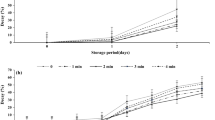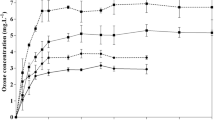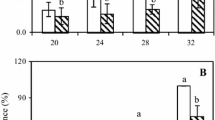Abstract
Ozone is a potent oxidizing agent which has the potential to extend fruit storage life by inhibiting disease development. Its oxidative action may also affect fruit quality. Fruit of bell pepper were exposed to 0 (control), 1, 3, 5, 7 and 9 ppm ozone at 12 °C and 95 % relative humidity (RH) for 3 days, and their quality was monitored during an additional 24 days of storage at 12 °C. Treatment with 7 and 9 ppm ozone significantly affected quality by enhancing fruit ripening as shown by higher rates of respiration and colour change and lower titratable acidity than that in untreated fruit. The treatments also increased membrane permeability, reduced firmness, enhanced weight loss and decreased ascorbic acid content of the fruit. Exposure to lower ozone concentrations (1 and 3 ppm) had no effect on fruit respiration, colour, titratable acidity and firmness. However, ascorbic acid concentration was increased. This could be due to the activation of fruit defence system that produces a high level of ascorbic acid to neutralize the oxidative activity caused by ozone. Fruit exposed to 3 ppm ozone were also rated by sensory evaluation as having better fruit flavour after 19 days of storage than that of fruit treated with 7 or 9 ppm ozone. Treatment of 3 ppm ozone also reduced anthracnose incidence. This shows that exposure to 3 ppm ozone has the potential to increase fruit ascorbic acid content, reduce disease incidence and maintain fruit physico-chemical quality.





Similar content being viewed by others
References
Alothman, M., Kaur, B., Fazilah, A., Bhat, R., & Karim, A. A. (2010). Ozone-induced changes of antioxidant capacity of fresh-cut tropical fruits. Innovative Food Science and Emerging Technologies, 11, 666–671.
Antony-Babu, S., & Singleton, I. (2009). Effect of ozone of spore germination, spore production and biomass production in two Aspergillus species. Antonie van Leeuwenhoek, 96, 413–422.
Apel, K., & Hirt, H. (2004). Reactive oxygen species: metabolism, oxidative stress, and signal transduction. Annual Review of Plant Biology, 55(1), 373–399.
Asghari, M., & Aghdam, M. S. (2010). Impact of salicylic acid on post-harvest physiology of horticultural crops. Trends in Food Science & Technology, 21(10), 502–509.
Barbosa-Martinez, C., Ponce de Leon-Garcia, L., & Sepulveda-Sanchez, J. (2002). Effects of ozone, iodine and chlorine of spore germination of fungi isolated from mango fruits. Mexical Journal of Phytopatology, 20(1), 60.
Bayoumi, Y. A. (2008). Improvement of postharvest keeping quality of white pepper fruits (Capsicum annuum, L.) by hydrogen peroxide treatment under storage conditions. Acta Biologica Szegediensis, 52(1), 1–15.
Bosland, P. W. & Votava, E. J. (2000). Peppers: vegetable and spice capsicums. Wallingford,Oxfordshire, CABI.
Castro, S. M., Saraiva, J. A., Domingues, F. M. J., & Delgadillo, I. (2011). Effect of mild pressure treatments and thermal blanching on yellow bell peppers (Capsicum annuum L.). LWT - Food Science and Technology, 44(2), 363–369.
Chauhan, O. P., Raju, P. S., Ravi, N., Singh, A., & Bawa, A. S. (2011). Effectiveness of ozone in combination with controlled atmosphere on quality characteristics including lignification of carrot sticks. Journal of Food Engineering, 102(1), 43–48.
FAOSTAT (2012). Food and Agriculture Organization of the United Nations. Available at http://faostat3.fao.org/faostat-gateway/go/to/home/E. Accessed 29 October 2013.
Food and Drug Administration (2001). Secondary direct food additives permitted in food for human consumption. Federal Register, 66(123), 33830.
Forney, C. F. (2003). Postharvest response of horticultural products of ozone. In D. M. Hodges (Ed.), Postharvest oxidative stress in horticultural crops (pp. 13–54). New York: Food Products Press.
Forney, C. F., Song, J., Hildebrand, P. D., Fan, L., & McRae, K. B. (2007). Interactive effects of ozone and 1-Methylcyclopropene on decay resistance and quality of stored carrots. Postharvest Biology and Technology, 45, 341–348.
Fox, A. J., Del Pozo-Insfran, D., Lee, J. H., Sargent, S. A., & Talcott, S. T. (2005). Ripening-induced chemical and antioxidant changes in bell peppers as affected by harvest maturity and postharvest ethylene exposure. HortScience, 40(3), 732–736.
Fry, S. C. (1998). Oxidative scission of plant cell wall polysaccharides by ascorbate-induced hydroxyl radicals. Biochemical Journal, 332, 507–515.
Gabler, F. M., Smilanick, J. L., Mansour, M. F., & Karaca, H. (2010). Influence of fumigation with high concentrations of ozone gas on postharvest gray mold and fungicide residues on table grapes. Postharvest Biology and Technology, 55(2), 85–90.
Gaetke, L. M., & Chow, C. K. (2003). Copper toxicity, oxidative stress, and antioxidant nutrients. Toxicology, 189(1–2), 147–163.
Hildebrand, P. D., Forney, C. F., Song, J., Fan, L., & McRae, K. B. (2008). Effect of a continuous low ozone exposure (50 nL L−1) on decay and quality of stored carrots. Postharvest Biology and Technology, 49(3), 397–402.
Jin-Hua, D. U., Mao-run, F. U., Miao-miao, L. I., & Wei, X. I. A. (2007). Effects of chlorine dioxide gas on postharvest physiology and storage quality of green bell pepper (Capsicum frutescens L. var. Longrum). Agricultural Sciences in China, 6(2), 214–219.
Kays, S. J. (1999). Preharvest factors affecting appearance. Postharvest Biology and Technology, 15(3), 233–247.
Khadre, M. A., Yousef, A. E., & Kim, J. G. (2001). Microbiological aspects of ozone applications in food: a review. Journal of Food Science, 66(9), 1242–1252.
Lewis Ivey, M. L., Nava-Diaz, C., & Miller, S. A. (2004). Identification and management of Colletotrichum acutatum on immature bell peppers. Plant Disease, 88(11), 1198–1204.
Lim, C. S., Kang, S. M., Cho, J. L., Gross, K. C., & Woolf, A. B. (2007). Bell pepper (Capsicum annuum L.) fruits are susceptible to chilling injury at the breaker stage of ripeness. HortScience, 42(7), 1659–1664.
Maalekuu, K., Elkind, Y., Leikin-Frenkel, A., Lurie, S., & Fallik, E. (2006). The relationship between water loss, lipid content, membrane integrity and LOX activity in ripe pepper fruit after storage. Postharvest Biology and Technology, 42(3), 248–255.
Mahasuk, P., Khumpeng, N., Wasee, S., Taylor, P. W. J., & Mongkolporn, O. (2009). Inheritance of resistance to anthracnose (Colletotrichum capsici) at seedling and fruiting stages in chili pepper (Capsicum spp.). Plant Breeding, 128(6), 701–706.
Minas, I. S., Karaoglanidis, G. S., Manganaris, G. A., & Vasilakakis, M. (2010). Effect of ozone application during cold storage of kiwifruit on the development of stem-end rot caused by Botrytis cinerea. Postharvest Biology and Technology, 58, 203–210.
Nigro, F., Ippolito, A., Lattanzio, V., Venere, D. D., & Salerno, M. (2000). Effect of ultraviolet-C light on postharvest decay of strawberry. Journal of Plant Pathology, 82(1), 29–37.
Ong, M. K., Kazi, F. K., Forney, C. F., & Ali, A. (2013). Effect of gaseous ozone on papaya anthracnose. Food and Bioprocess Technology, 6(11), 2996–3005.
Palou, L., Crisosto, C. H., Smilanick, J. L., Adaskaveg, J. E., & Zoffoli, J. P. (2002). Effects of continuous 0.3 ppm ozone exposure on decay development and physiological responses of peaches and table grapes in cold storage. Postharvest Biology and Technology, 24, 39–48.
Palou, L., Smilanick, J. L., Crisosto, C. H., Mansour, M., & Plaza, P. (2003). Ozone gas penetration and control of the sporulation of Penicillium digitatum and Penicillium italicum within commercial packages of oranges during cold storage. Crop Protection, 22(9), 1131–1134.
Ranggana, S. (1986). Handbook of analysis and quality control for fruit and vegetable products. New Delhi: McGraw-Hill.
Rodoni, L., Casadei, N., Concellon, A., Alicia, A. R. C., & Vicente, A. R. (2010). Effect of short-term ozone treatments on tomato (Solanum lycopersicum L.) fruit quality and cell wall degradation. Journal of Agricultural and Food Chemistry, 58, 594–599.
Sakaki, T., Kondo, N., & Sugahara, K. (1983). Breakdown of photosynthetic pigments and lipids in spinach leaves with ozone fumigation: role of active oxygens. Physiologia Plantarum, 59(1), 28–34.
Sakaldaş, M., & Kaynaş, K. (2010). Biochemical and quality parameters changes of green sweet bell peppers as affected by different postharvest treatments. African Journal of Biotechnology, 9(48), 8174–8181.
Sakihama, Y., Cohen, M. F., Grace, S. C., & Yamasaki, H. (2002). Plant phenolic antioxidant and prooxidant activities: phenolics-induced oxidative damage mediated by metals in plants. Toxicology, 177(1), 67–80.
Tiwari, B. S., Belenghi, B., & Levine, A. (2002). Oxidative stress increased respiration and generation of reactive oxygen species, resulting in ATP depletion, opening of mitochondrial permeability transition, and programmed cell death. Plant Physiology, 128(4), 1271–1281.
Torlak, E., Sert, D., & Ulca, P. (2013). Efficacy of gaseous ozone against Salmonella and microbial population on dried oregano. International Journal of Food Microbiology, 165(3), 276–280.
Vicente, A. R., Pineda, C., Lemoine, L., Civello, P. M., Martinez, G. A., & Chaves, A. R. (2005). UV-C treatments reduce decay, retain quality and alleviate chilling injury in pepper. Postharvest Biology and Technology, 35(1), 69–78.
Whangchai, K., Saengnil, K., & Uthaibutra, J. (2006). Effect of ozone in combination with some organic acids on the control of postharvest decay and pericarp browning of longan fruit. Crop Protection, 25(8), 821–825.
Xing, Y., Li, X., Xu, Q., Yun, J., Lu, Y., & Tang, Y. (2011). Effects of chitosan coating enriched with cinnamon oil on qualitative properties of sweet pepper (Capsicum annum L.). Food Chemistry, 124, 1443–1450.
Yuen, C. M. C., & Hoffman, H. (1993). New capsicum varieties: storage suitability and consumer preference. Food Australia, 45(4), 184–187.
Acknowledgments
This study was supported by MedKlinn International Sdn. Bhd. and the School of Biosciences, The University of Nottingham Malaysia Campus.
Author information
Authors and Affiliations
Corresponding author
Rights and permissions
About this article
Cite this article
Alwi, N.A., Ali, A. Dose-dependent Effect of Ozone Fumigation on Physiological Characteristics, Ascorbic Acid Content and Disease Development on Bell Pepper (Capsicum annuum L.) During Storage. Food Bioprocess Technol 8, 558–566 (2015). https://doi.org/10.1007/s11947-014-1419-2
Received:
Accepted:
Published:
Issue Date:
DOI: https://doi.org/10.1007/s11947-014-1419-2




